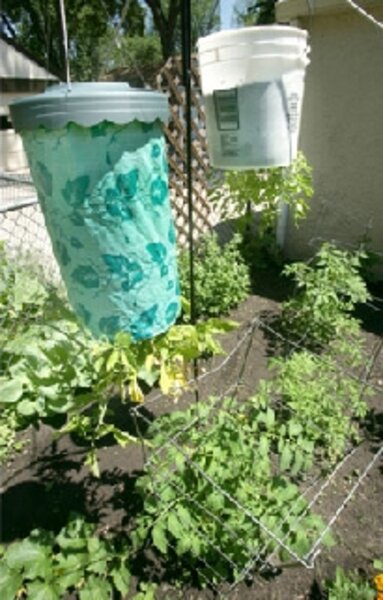The verdict on upside-down tomatoes
Loading...
| MINNEAPOLIS
Since May, I've been conducting a tomato experiment in my backyard. I've been growing tomatoes in the ground, in a homemade upside-down planter, and in a commercial upside-down planter called the Topsy Turvy.
The growing season has come to an end. The harvest is in. So, what's the verdict? Are the TV ads promoting the upside-down planters true? Is it really a better way to grow tomatoes? Here's what happened in my yard:
May and June: During a late frost, I brought the Topsy Turvy tomatoes inside, while the poor in-ground plants shivered under plastic covers. Our record-breaking cool weather in Minnesota wasn't the best for tomato-growing, but the upside-down tomato plants grew steadily. The Early Girl sent out timid shoots, then yellow flowers followed quickly by a tiny green tomato. The in-ground Early Girl appeared to be in shock and didn't grow for weeks.
July: The first tomato of the season came from the Topsy Turvy. The runner-up was a bite-sized fruit from my homemade upside-down planter. But the earthbound plants started catching up and were loaded with promising green fruit. I learned (the hard way) that the upside-down planters need lots of water — a gallon a day — and fertilizer at least once a week.
August: Tomatoes were coming fast and furious from all of the plants. It was easier to pick tomatoes from the plants in the air. However, the Early Girls grown upside-down were smaller than the fruit from the ground. With drought conditions, I watered the garden with a sprinkler every few days, but I had to pour a gallon of water into the upside-down planters every day. Squirrels snatched some of the in-ground fruit, but didn't manage to get the hanging fruit.
September: Fusarium blight hit the in-ground tomato plants, causing the leaves and branches to turn brown, then eventually killing the plants. The upside-down plants were untouched by blight and still produced fruit, but I was tired of all the watering and fertilizing.
The verdict: There's no clear winner. The upside-down plants bore fruit earlier, were easier to pick, seemed less likely to get diseased and were relatively squirrel-proof. (I should note that the Topsy Turvy outperformed my homemade version.) However, the fruit grown in the upside-down planters was slightly smaller and a little less tasty. And you really have to baby these plants, watering every day and fertilizing regularly. If you have little or no garden space, plenty of sun and time to nurture, the Topsy Turvy is a good option. But upside-down tomatoes aren't the hands-down winners.
Editor’s note: For more on gardening, see the Monitor’s main gardening page, which offers articles on many gardening topics. Also, check out our blog archive and our RSS feed. You may want to visit Gardening With the Monitor on Flickr. Take part in the discussions and get answers to your gardening questions. If you join the group (it’s free), you can upload your garden photos and enter our contests.





